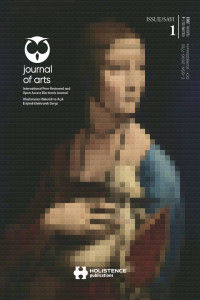Abstract
The progress in information and communication technologies creates a significant social transformation. Art in the early 2000s Art; It is the expression of creativity and imagination through tools such as music, dance, sculpture and painting. In the digitalizing world, the artist’s use of technological tools to express his feelings and thoughts can be defined as digital art. Digital art, which is a combination of art and technology, covers all branches of art in which the artist uses technological devices to produce his works. The main difference between traditional art and digital art is that the space in which it is designed is different. For example, in traditional art, a painter uses canvas while producing his work. In digital art, digital tools such as a computer or camera are used in the design of the work. The concept of digital art covers a wide area. From graphic arrangements to reproduction and copying of traditional art forms such as photography, sculpture, painting; Many applications, from engineering construction to projects involving artificial intelligence, can be examined under the title of digital art. The aim of this article is to examine the development and transformation of digital art in the historical process, the way they exist in the exhibition and art market, and to make predictions about the future of digital art by identifying the main reasons for this change in the context of technology. As a method, classifications are made by literature research and description method. According to the findings, the use of digital technologies as a means of expression by artists has been on the agenda since the first emergence of digital technologies and artists who follow technology closely are also pioneers in the use and spread of these technologies. In addition, digital art, which is under the authority of art institutions, can have an independent digital presence and create its own autonomous space thanks to NFT technologies.
References
- İstanbul: Remzi Kitabevi Yayınları.
- OCVİRK, O. G., STİNSON R. E., WİGG, PHİLİP R.,
- BONE, ROBERT O., CAYTON, DAVİD L. (2013). Sanatın Temelleri Teori ve Uygulama. İzmir: Karakalem Kitabevi Yayınları.
- SHANKEN, E. A. (2012). Sanat ve Elektronik Medya. İstanbul: Akbank adına Agora Kitaplığı.
- WANDS, B. (2006). Dijital Çağın Sanatı. Çev. Osman Akınhay. İstanbul: Akbank Kültür ve Sanat Dizisi.
- ARSEVEN, C.E.. (1975). Sanat Ansiklobedisi. IV Cilt. İstanbul: Milli Eğitim Basımevi.
- GOMBRİCH, E.H. (1980). Sanatın Öyküsü.
Abstract
Bilgi ve iletişim teknolojilerindeki hızlı değişim ciddi bir toplumsal dönüşüm yaratmaktadır. 2000’li başlarında Sanat; yaratıcılığın ve hayal gücünün müzik, dans, heykel, resim gibi araçlarla ifade edilmesidir. Dijitalleşen dün-yada sanatçının duygu ve düşüncelerini ifade etmek için teknolojik araçları kullanması, dijital sanat olarak tanım-lanabilir. Sanat ve teknolojinin birleşimi olan dijital sanat, sanatçının eserlerini üretmek için teknolojik cihazları kullandığı tüm sanat dallarını kapsar. Geleneksel sanat ile dijital sanat arasındaki temel fark, tasarlandığı alanın farklı olmasıdır. Örneğin geleneksel sanatta bir ressam, eserini üretirken tuval kullanır. Dijital sanatta ise eserin tasarımında bilgisayar ya da fotoğraf makinesi gibi dijital araçlar kullanılır. Dijital sanat kavramı, geniş bir alanı kapsar. Grafik düzenlemelerinden fotoğraf, heykel, resim gibi geleneksel sanat formlarının yeniden üretilip kopya-lanmasına; mühendislik inşasından yapay zekâ uygulaması içeren projelere kadar pek çok uygulama, dijital sanat başlığı altında incelenebilir. Bu makaledeki amaç tarihsel süreçte dijital sanatın gelişimi ve dönüşümünü, bunların sergileme ve sanat piyasasındaki var olma biçimlerini incelemek, bu değişimdeki temel nedenleri teknoloji bağla-mında tespit ederek dijital sanatın geleceği hakkında öngörülerde bulunmaktır. Yöntem olarak literatür araştırması ve betimleme yöntemiyle sınıflandırmalar yapılmaktadır. Elde edilen bulgulara göre Sanatçılar ifade aracı olarak dijital teknolojileri kullanması dijital teknolojilerin ilk ortaya çıkışından itibaren gündeme gelmiş ve teknolojiyi yakın takipte olan sanatçıların bu teknolojilerin kullanılmasını ve yaygınlaşmasında da öncü olduklarıdır. Buna ek olarak sanat kurumlarının otoritesi altında olan dijital sanatın bugün NFT teknolojiler sayesinde bağımsız erişime açık dijital varlık gösterebildiği ve kendi özerk alanını oluşturabildiğidir.
References
- İstanbul: Remzi Kitabevi Yayınları.
- OCVİRK, O. G., STİNSON R. E., WİGG, PHİLİP R.,
- BONE, ROBERT O., CAYTON, DAVİD L. (2013). Sanatın Temelleri Teori ve Uygulama. İzmir: Karakalem Kitabevi Yayınları.
- SHANKEN, E. A. (2012). Sanat ve Elektronik Medya. İstanbul: Akbank adına Agora Kitaplığı.
- WANDS, B. (2006). Dijital Çağın Sanatı. Çev. Osman Akınhay. İstanbul: Akbank Kültür ve Sanat Dizisi.
- ARSEVEN, C.E.. (1975). Sanat Ansiklobedisi. IV Cilt. İstanbul: Milli Eğitim Basımevi.
- GOMBRİCH, E.H. (1980). Sanatın Öyküsü.
Details
| Primary Language | Turkish |
|---|---|
| Journal Section | Research Article |
| Authors | |
| Publication Date | February 5, 2023 |
| Published in Issue | Year 2023 Volume: 6 Issue: 1 |


